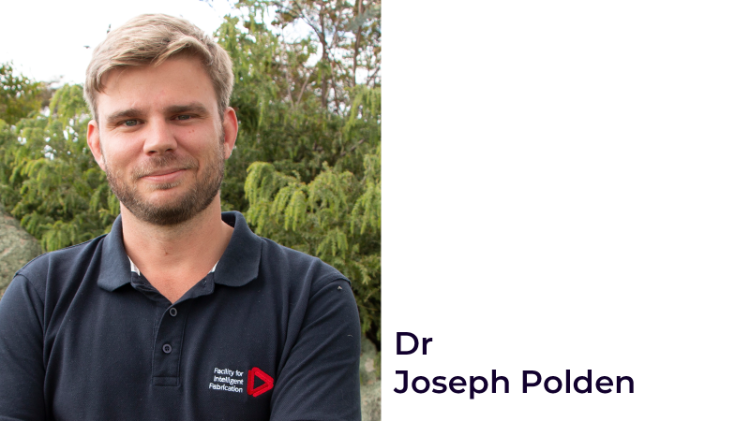Meet the team: Facility for Intelligent Fabrication
Understanding perspectives from the project leader and early career researcher
February 2, 2022
The Facility for Intelligent Fabrication (FIF) was formed in recognition of the changing business climate, as the Illawarra transitions from large-scale heavy manufacturing, and the need for local manufacturers to innovate and adapt to remain competitive. In this piece, we speak to one of the groups leaders and an early career researcher to understand their different perspectives and roles.
Meet the project leader

I am a research leader within the Facility of Intelligent Fabrication (FIF)
What are the key areas your group works within?
There are several key industry sector areas the FIF operates, but we predominantly focus on advanced manufacturing and materials, joining and fabrication research.
What are 3 key objectives of the group?
The key objectives of our group include;
- creating new ways to improve manufacturing efficiency that allows industry to remain sustainable into the future,
- simplifying and reducing the risk of implementing technologies to a level that can be easily utilised by industry, and finally
- a focus on translating this research to the factory floor so that our research can directly benefit and impact society’s challenges today.
What has been a highlight win for the group over the last few years?
A significant achievement the group made over a decade long research initiative, was the development of new methods to simplify the programming of robots for the defence industry. This research was designed to remove the barrier of complex programming of robots by developing a software tool with embedded algorithms to deal with challenging robot movements for defence vehicle manufacture. As a result of this research, the FIF contributed to winning the DSTO Eureka Prize for Safeguarding Australia, followed by the technology being spun out of the university as a start-up company. Today, this research is being used worldwide to help revolutionise the way we program robots across multiple industry sectors.
What are you excited about for the future?
Manufacturing worldwide is having a resurgence in the use of automation. Historical trends to use cheap labour to manufacture the world’s goods is beginning to run its course, and so more efficient and sustainable ways to manufacture, including Industry 4.0 principles, are now driving manufacturing back to advanced economies including Australia. The FIF is front and centre of this new industrial revolution and the technologies we develop and specialise in, are highly relevant to this new global phenomenon.
Why should people consider postgrad affiliations with your group? What does the group offer?
The translational nature of our research being practically applied to industry is incredibly satisfying when you see the technologies we develop, taken all the way to fruition. Typically, post grad research is blue sky, highly innovative and often the pathway to practical utilisation is difficult to achieve. The FIF is designed to take novel ideas and incubate them for future industry use. This is incredibly rewarding for the researcher to see their hard work having the potential of making a practical societal difference.
Why should industry, community or business consider collaboration with your group? What does the group offer?
The FIF’s clear focus on translating research to industry for industry utilisation is a key sign our group of researchers and research engineers are committed to developing technologies for societal and practical use. Collaboration is the pathway to ensuring that cutting-edge technologies are not only understood but can be packaged in a way to target a community or an individual business’ unique challenges.
Meet the early career researcher
I am a Mechanical Engineer who works in conjunction with the (FIF).
What's your educational background?
UOW Alumni! I completed my Bachelor of Mechanical Engineering here at UOW in 2008. I then undertook my PhD studies with several academic staff I had built relationships with in my final years as an undergraduate student.
How did you find yourself within this group?
I completed my PhD studies with the Welding Engineering Research Group here at UOW, before spending several years overseas completing a post-doctoral fellowship. During this period, the research group I had completed my thesis studies with underwent a transformation into the Facility for Intelligent Fabrication, which along with it brought new and expanded opportunities in manufacturing-based research. It was not long until I was able to find a role back within the team.
What’s your specialty and current research interest?
I have a specialty in developing software systems to enhance the capabilities of industrial robots for manufacturing tasks. Typically, this involves developing software systems which integrate sensors (such as cameras, lasers, point-cloud scanners and more) into a robotic manufacturing task, such as welding, grasping, painting, gluing (or whatever needs be done!)
What are some amazing things this group has achieved?
The traditional strength in our research group lies in the fusion of traditional welding know-how with advanced robotic automation. An excellent example of this is in our , which make use of low-cost robotic welding systems for 3D printing of metallic components.
Many important technological breakthroughs and research papers on the topic were conducted by the senior research staff and student cohort in our group. These technologies are now beginning to filter their way into manufacturing facilities around the globe. An excellent outcome for a once experimental technology and testament to the ingenuity of those involved.
What has been your personal research highlight?
I look back very fondly on my time as a PhD student. We were presented with a project from an industry partner who had an overly complex robotic welding system which was underutilised due to the challenges associated with programming it.
We were able to develop a software system to automate and simplify many of the time-consuming tasks their engineers were encountering during this complicated programming process. It was a highlight for me because there was a direct use case for my research at the time and we were able to implement our final solution into our project partners’ manufacturing facility. After a number of years of development, it was great to see our work put into action which was a great feeling for a budding engineer!
If you could give a future researcher/employee advice on your industry, what would it be? Would you encourage them to delve further into a growth topic or area?
I would say that a career in research Offers an incredible opportunity to apply oneself as an ‘actual’ engineer. Indeed, when undertaking your masters or PhD one can often find themselves focussed on a narrow sliver of a wider problem. However, once you are established in the field you are presented many opportunities to turn your mind to true to engineering problems spanning many diverse topics or technology areas. For those that are passionate about engineering, this may well be the greatest part of this career pathway.
There are many opportunities out there for graduating engineers, however I believe more should consider a career in technology research as it will regularly provide stimulating tasks for put your mind to.
Get in touch with the Facility of Intelligent Fabrication (FIF) team
To get in touch with
To get in touch with
